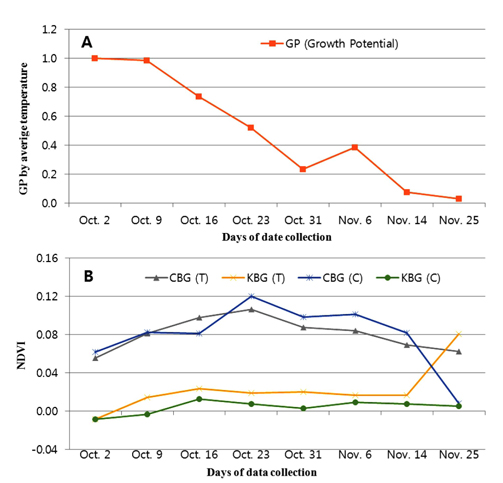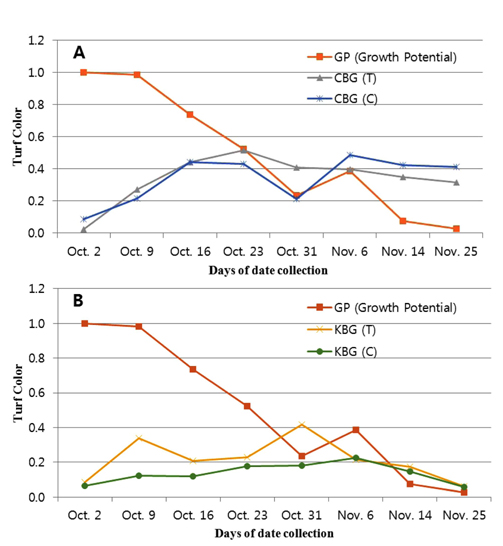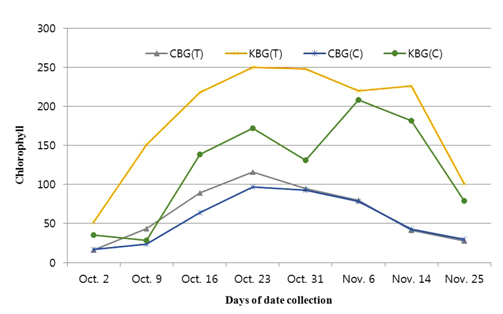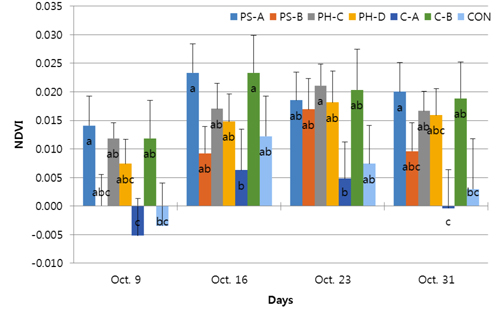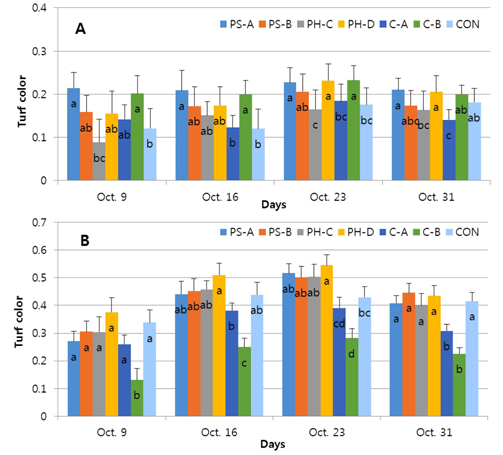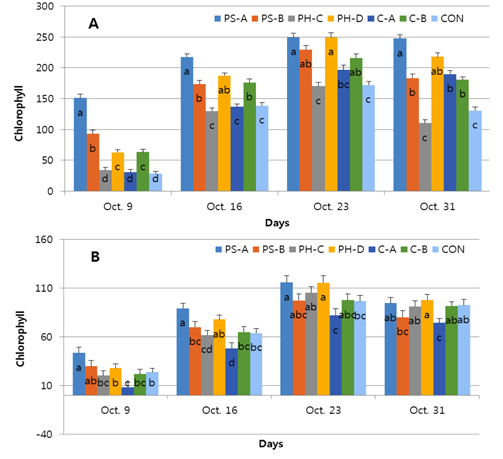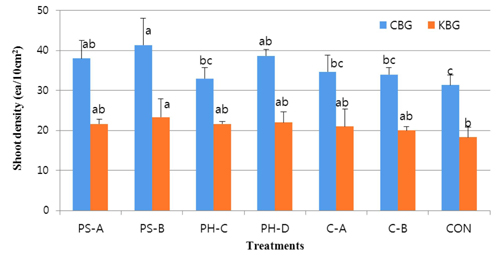



Four preparations of liquid turfgrass fertilizers were tested cool season turfgrasses during fall season. The preparations of PS-A, PS-B, PH-C and PH-D for commercial products were contained with essential nutrient elements, seaweed extract, amino acids, and humus substance. Growth and quality of creeping bentgrass (
한지형 잔디는 우리나라 여름철 기후에서 생육에 부적합하지만 대부분 골프장의 그린과 그린주변 및 티 박스에 식재 되어 있다. 그린에 식재 된 잔디는
한지형 잔디의 생육과 품질 유지는 기후와 토양 환경이외도, 병충해관리와 시비관리에 따라서도 큰 차이를 보이지만, 대부분의 관리자들은 경험에 의해 비료의 종류를 선택하여 사용하고 있다. 그 종류로는 농작물재배용 화학비료를 비롯하여 잔디전용화학비료 및 아미노산비료 등 다양하게 사용되고 있으나(Chang et al., 2010), 많은 종류의 비료들이 미국에서 수입되는 완효성비료와 액상비료가주종을 이루고 있다. 이들 비료의 사용량도 2002년 월드컵을 기점으로 골프장 수의 증가로 인하여 뗏장 잔디를 생산하는 기업과 농가의 증가로 크게 늘어나고 있다. 국내에서 잔디전용으로 개발된 비료는 많지 않음으로 골프장잔디관리와 뗏장 생산 농가를 위해서 전용비료의 개발이 시급하다.
잔디전용비료의 개발을 위해서는 환경을 고려하여 속효성 입상비료나 완효성입상비료 외에 액상비료 등 다양한 종류의 제형을 개발하는 것이 필요하다. 액상비료는 사용이 편리하고 환경오염을 줄일 수 있으며, 사용효과가 빠른 장점이 있으나(Chang et al., 2010), 국내 잔디재배농가는 관행적으로 잔디의 생육과 품질 관리를 위하여 농업용입상 화학비료에 의존하고 있는 실정이다(Chang et al., 2010). 그러나 화학비료 이외에도 잔디의 생육을 증진시키는 여러 물질이 알려져 있다. 동물의 모발이나 가축 부산물에서 추출한 아미노산이나 대서양 과 북극해에서 자생하는 갈색 해초(
해초 추출액의 효과는 식물생장증진, 작물 수확량증대, 토양으로부터 무기성분의 흡수증진, 서리나 스트레스조건에서 식물에 저항성증진, 곰팡이 병의 발생감소와 해충 침입을 감소시키고, 과실의 저장손실을 줄이고, 종자발아를 증진 및 작물의 품질을 향상시킨다(Alina, 2005; Berlyn and Russo, 1990; Norrie et al., 2002). 원예재배에서 생육을 증진시키는 유기생물자극제로서 사용하고 있으며(Verkleij, 1992), 또 다른 해초인
본 연구는 잔디 전용 비료를 개발하기 위하여 식물생장에 필수적인 영양원소를 기본으로 하여 잔디의 생육을 증진시키는 아미노산, 해초추출물, 휴믹산 및 목초액 등을 이용하여, 여러 조합의 액상제형을 개발하여 가을철 잔디의 생장, 잔디색, 엽록소함량 및 뿌리발육에 대한 효과를 조사하고자 수행되었으며, 그 기초자료를 바탕으로 가장 우수한 제형을 선발하여 상업용 제품으로 등록하고자 한다.
잔디에 생육에 필수적인 수용성인 영양소와 해초추출물, 아미노산 및 휴믹산을 이용하여 4종류의 제형을 개발하여 사용하였다. 4종류의 제형 중 2종류의 제형은 해초 추출물을 이용하였고, 다른 2종은 제형은 아미노산과 휴믹산을 이용하였다. 개발 제형의 명칭은 PS-A, PS-B, PH-C 및 PH-D로 사용하였다. 이들 제형에는 쌀겨에서 추출한 천연물과 필수영양원소인 Co(NH2)2, H3PO4, KCl, Na2B8O13.4H2O, ZnSO4. 7H2O, EDTA-Fe, (NH4)6Mo7O24.4H2O, MnSO4. H2O, MgSO4.7H2O, CuSO4.5H2O을 사용하여 조성되었다. 개발 제형은 비료관리법에 맞게 주성분을 함유함하고 있으며, 영양원소의 흡수를 증가시키는 보조물질을 첨가하였고, 사용의 편리성을 고려하여 액상으로 제형화 하였다. 주요 성분은 비료관리법 표시기준에 준하여 유효성분 함유량은 PS-A는 T-N: 1.8%, P2O3: 8.8%, K2O: 7.1%, B2O3: 0.2%, Mo: 0.05%, Zn: 0.05%, Fe: 0.1%, Cu: 0.05%, MnO: 0.1%, MgO: 0.1%이고, PS- B는 T-N: 1.5%, P2O3: 7%, K2O: 8.1%, B2O3: 0.4%, Mo: 0.05%, Zn: 0.07%, Fe: 0.1%, Cu: 0.05%, MnO: 0.1%, MgO: 0.4%이다. PH-C는 T-N: 2%, P2O3: 8.4%, K2O: 6.2%, B2O3: 0.3%, Mo: 0.1%, Zn: 0.5%, Fe: 0.1%, Cu: 0.1%, MnO: 0.1%, MgO: 0.3%이고, PH- D는 T-N: 2%, P2O3: 7%, K2O: 5%, B2O3: 0.2%, Mo: 0.1%, Zn: 0.4%, Fe: 0.1%, Cu: 0.05%, MnO: 0.1%, MgO: 0.4% 이다.
포장시험은 한지형 뗏장잔디를 생산하는 경남 합천군 합천읍 (주)한울 재배농장에서 실시하였다. 시험포장은 모래로 조성되었다. 시험용 잔디의 종류는 켄터키블루그래스종의 혼합품종(Midnight 33%, Moonlight 33%, Prosperity 33%)과 크리핑벤트그래스 Penn A-1 품종을 사용하였다. 켄터키블루그래스 품종은 2013년 4월 6일에 파종하였으며, 크리핑벤트그래스 품종은 4월 20일에 파종하였다. 관리는 (주)한울의 뗏장잔디 관리기준에 준하여 관리하였고, 시험은 100일 이상 생육한 성체 식물에서 실시하였다. 시험구의 크기는 반복당 1 m×1 m 하였고, 완전 임의 배치법에 3반복으로 수행하였다. 공시비료는 개발 제형 4종류와 대조비료는 시판되는 해초추출물 파우다 1종류, 완효성 입상비료(21-17-17) 1종을 사용하였다. 공시비료의 사용 농도는 원액을 물에 500배로(2 ml L−1) 희석하여 반복당 1 L의 양을 엽면 살포하였다. 엽면살포는 2013년 9월 25에 1회 살포 후 7일 간격으로 3회 연속 살포하였다. 대조비료인 해초파우다는 공시제제와 동일하게 살포하였으며, 완효성비료를 질소성분을 기준으로 반복당 2 g Vm−2으로 산출하여 1회 시비하였다.
잔디의 지상부 조사는 Chang et al. (2009)이 실시한 방법에 준하여 실시하였다. 잔디 생장량을 측정하는 생장지수, 잔디 품질 평가를 위한 엽색 및 엽록소 함량을 조사하였다. 2013년 9월 25일 공시제제 처리 전에 생장지수, 엽색 및 엽록소함량을 조사 한 후, 1차 공시제제를 동력분무기를 이용하여 엽면 살포 하였고, 그 이후 7일 간격으로 2회 와 3회 살포하는 동안 공시 제제를 살포하기 전에 2차와 3차조사를 한 후에 동일한 방법으로 살포 하였다. 3회 살포를 마친 후에는 10일 간격으로 11월 25일까지 조사를 하였다.
잔디의 생장 지수 또는 정규 식생차 지수 조사는 Chang et al, (2009)등의 방법에 따라서 Field Scout CM1000 NDVI Meter (Spectrum Technologies Inc.)을 이용하여 NDVI (Normalized Difference Vegetation Index) 값으로 나타내었다. 생장지수 산출은 적색영역의 가시광선과 근적외선에서 녹색 식물의 반사율 차이를 이용하는 원리로 식생분포상황 조사에 이용되며 공식은 다 음과 같다.NIR = 근적외선역의 관측치(Landsat 7 ETM+의 경우에는 band 4를 이용)VIS = 가시영역의 관측치(분광되고 있는 경우는 적색영역, Landsat 7 ETM+의 경우에는 band 3를 이용) NDVI 값은 1과 1사이에 분포한다.
잔디 색(GCI) 측정은 Field Scout TCM500 NDVI turf color meter (Spectrum Technologies Inc.)을 이용하여 빛이 있는 날에 측정을 하다. 660 nm의 붉은색 파장과 850 nm의 적외선의 분광 밴드(spectral bands) 파장을 잔디로부터 반사되는 빛을 측정하여 지수화 한 값(index)을 사용하였다.
엽록소함량은 Field Scout CM1000 Chlorophyll meter을 이용하여 측정하였다. 엽록소 측정 원리는 잔디 잎에 엽록소 전체 함량을 측정하는 것으로 700 nm-840 nm의 빛의 파장을 감지하여 엽록소함량을 0-999까지 index로 나타내며, 측정 거리가 28.4 cm에서 측정 시 잎에 측정 직경은 1.10 cm이다.
시험포장지의 잔디 생장력은 조사 일에 전의 평균온도와 최적온도를 이용하여 산출하였다(Mangiafico and Guillard, 2007). GP =생장력 (단위 0 − 1), e = 2.71828 (산술적인 상수) t = 잔디재배지의 평균온도(℃), to = 최적온도(C3 형 잔디: 20℃, C4 형 잔디: 31℃) var = 최적온도로부터의 온도의 변화에 대한 생장력 변화 적용(C3형 잔디: 5.5; C4형 잔디: 8.5)
공시액상제제 4종류를 엽면시비 후 지하부 생육특성인 뿌리길이, 뿌리생중량 및 잔디개체수를 조사하였다. 잔디의 뿌리 길이는 Mascaro Profile Sampler, MPS1-S (W2×L8×D18 cm, Turf-tech Inc.)를 이용하여 샘플을 채취한 뒤 뿌리길이를 실측하였다. 뿌리 생체중은 토양 층에서 2 cm 밑의 뿌리를 채취하여 수세한 후 중량을 측정하였다. 잔디의 개체수(분얼경수) 조사는 켄터키블루그래스에서는 10 cm2 에서의 개체수를 조사하였고, 크리핑벤트그래스는 2 cm2 에서의 개체수를 조사하였다. 조사는 공제제제를 10일 간격 3회 살포 후 20일에 조사하였다.
통계분석은 SAS (Statistical Analysis System) 프로그램을 이용하여 처리구에 대한 잔디 잎색, 엽록소함량 및 생육지수에 대하여 종간(품종)에 Fit Y by X 모델에서 one way 분석을 위하여 평균(means)/ANOVA 분석/T-test와 표준편차 및 all pairs, Tukey HSD로 통계처리를 하였다(SAS, 1999).
공시 제형으로 사용한 개발 제형의 이화학 성 및 안정성은 다음과 같다. PS-A와 PS-B의 물리성은 pH는 5.6이고, 상업용 제품으로 유통을 고려하여 45℃의 고온과 −20℃ 저온에서 7일간 보관 시 색상의 변화나 침전이 발생하지 않았다. 유효성분도 분석한 결과 성분함량에도 아무런 변화가 없었다(자료 미 제시). PH-C 와PH-D제형의 pH는 3.5이며, 45℃의 고온과 −20℃ 저온에서 색상의 변화, 침전현상 및 유효성분의 변화가 없었다. 비료관리법상 제4종복합비료란 모든 원료가 수용성이며, 질소, 인산, 가리 중 2종류 이상이 10%를 함유하고, 미량요소는 2종 이상을 보증하면 된다. 여기서 미량요소란, 철, 붕소, 아연, 동, 망간, 몰리브덴이다(Official Standard of Commercial Fertilizer, 2010).
잔디전용비료로 개발된 PS-A제형의 살포한 구와 무처리 구간에 잔디품질과 생장력을 비교한 결과는 Fig. 1, Fig. 2 및 Fig. 3과 같다.
평균온도에의 의한 잔디 생장력은 10월 9일 이후로는 급격하게 약화되는 경향을 보였다. 하지만, 잔디의 종류별 잔디생장을 생장지수(NDVI)로 조사한 결과 Fig. 1B과 같이 종간에 차이도 있었으며, 처리구에서 생장이 10일 23일까지 증가하고 그 이후로 낮아지는 것을 볼 수 있었다. 잔디의 생장은 살포구에서 10월 23일부터 11월 4일까지 증가하는 것이 통계적인 유의 차이가 있었다(Fig. 2).
잔디 색은 시험시작일부터 10월 30일까지 증가하고 11월 6일부터 급격하게 감소하는 것을 볼 수 있었다(Fig. 2A). 크리핑벤트그라스는 10월 23일부터 10월 30일까지 통계적인 유의차이를 보였고, 켄터키블루그라스는 공시제 제 2회 살포 후 조사일인 10월 9일과 3회 살포후인 10월 31일 조사에서 통계적인 유의 차이를 보였다(Fig. 2B).
엽록소 함량은 켄터키블루그라스와 크리핑벤트그라스에서 공시제제를 2회살포 후 조사부터 증가하여 통계적인 유의차이를 보였다(Fig. 3). 엽록소함량은 두 종간에 큰 차이를 보였다. 특히 켄터키블루그라스는 1회 살포 후부터 엽록소함량이 증가하기 시작하여 11월 14일까지 유지되는 경향을 보였으나, 크리핑벤트그라스는 10월 23일까지만 증가하였다.
잔디의 생육에 미치는 평균온도를 이용하여 잔디생장력을 산출하여 경시적인 잔디생장력과 포장시험에서 조사한 생장지수, 잔디 색 및 엽록소 함량을 비교하여 조사한 결과 큰 차이를 보였다. 경시적으로 평균 온도가 낮아지는 후반기로 갈수록 평균온도로 산출한 한지형 잔디의 생장력은 10월 9일이후 부터 크게 둔하 되는 반면에 실제 포장에서 조사한 생장지수, 잔디색 및 엽록소 함량은 상대적으로 서서히 감소하는 것을 볼 수 있었다. 특히 켄터키 블루그라스 종은 크리핑벤트그라스 종에 비하여 생장지수와 엽록소함량이 크게 높았으며, 잔디색은 큰 차이를 보이지 않았다. 이 결과로 보아 한지형 잔디는 기온이 낮아질수록 생장의 크게 감소하지만, 잔디의 품질을 나타내는 잔디색과 녹색을 유지하는 엽록소함량은 11월 6일까지 증가하다가 그 이후로 점차 감소하는 것을 볼 수 있었다.
개발제형 살포에 의한 생장지수, 잔디색 및 엽록소함량에 미치는 영향에 대한 분산 분석을 한결과, 잔디의 종류, 처리구 및 공시제제에서 유의 차이가 있었다(Table 1).
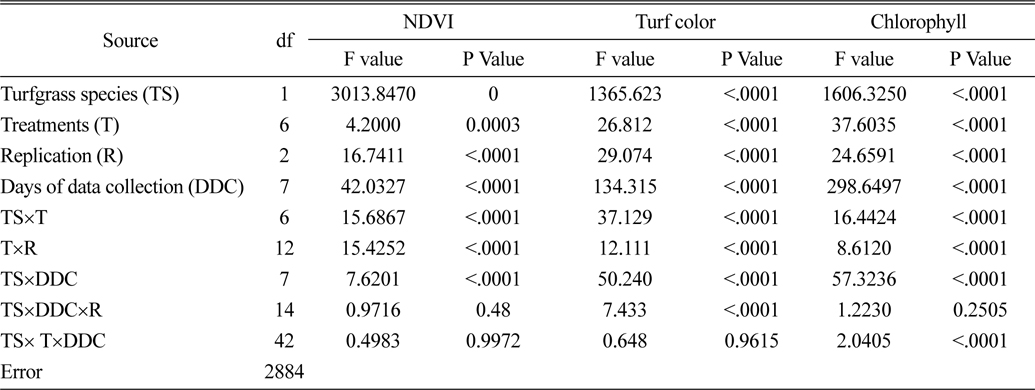
Analysis of variance of NDVI, turf color and chlorophyll of Kentucky bluegrass and creeping bentgrass by foliar application with 4 preparations for development of commercial products during fall season in field experiments.
잔디생장지수는 개발 제형을 2회 살포 후 조사에서 대조구 대비
잔디 색은 켄터키블루그라스 종과 크리핑벤트그라스 종에 엽색에 미치는 영향을 조사한 결과, Fig. 5와 같다. 켄터키블루그래스 혼합품종은 개발제형 2회 살포 후 10월 9일, 3회 살포 후 10월 16일 및 23일 조사에서 통계적인 유의차이를 보였다. PS-A와 완효성비료 처리구에서 가장 우수한 효과를 보였다. 크리핑벤트그래스 품종 “PennA-1”은 개발제형을 3회 살포 후인 10월 23일 조사에 처리구간의 통계적으로는 유의성 차이는 보였다.
엽록소 함량은 켄터키블루그라스 잔디에서 2회 살포 후부터 10월 31일 통계적인 유의 차이를 보였다(Fig. 6A). 개발 제형인 PS-A에서 가장 우수한 효과가 있었다. 크리핑 벤트그라스 잔디의 엽록소함량은 2회 엽면 살포 후 10월 9일, 16일 및 23일에서 통게적인 유의차이를 보였으며 (Fig. 6B), 개발 제형인 PS-A의 효과가 가장 우수하였다.
잔디의 지하부의 생장에 미치는 영향을 조사한 결과 분얼에 의한 잔디개체수 밀도에서 크리핑벤트그라스에서 통계적인 유의성의 차이를 보였으나(Fig. 7), 켄터키블루그라스에서는 유의차이가 없었다. 해초추출물을 원료로 한 개발 제형 PS-A와 PS-B가 휴믹산과 아미노산을 원료로 한 액상PH-C와 PH-D 살포구보다 우수하였다.
본시험을 통해서 개발 제형은 서로 다른 원료의 함량을 조성하여 개발하여 가을철 생장이 완성한 10월에 조사한 결과, 개발제형의 종류에 따라서 큰 차이가 나타나는 것을 볼 수 있었다. 이는 개발제형의 종류에 따른 원료의 함량조성에 따라서 효과가 다르게 나타난다는 것을 볼 수 있었다. 조사항목 중 개발제형 간에 가장 뚜렷한 차이를 보이는 것은 엽록소 함량에서 볼 수 있었다. 엽록소 함량은 잔디 종간에도 뚜렷한 차이를 보였지만, 개발제형의 살포효과가 가장 높게 나타난 것을 볼 수 있었는데, PS-A가 가장효과가 높게 나타난 것을 볼 수 있었다. 개발 제형의 종류는 PS-A와 PS-B의 제형은 해조추출물의 원료를 기반으로 만들어진 것이지만, 원료의 함량의 차이에 의해 효과가 다르게 나타난 것을 알 수 있었다. 이와 같이 지상부 생육, 잔디색 및 엽록소함량에는 있는 해조추출물 제형이 효과가 있었지만, 지하부 생육에서는 휴믹산을 원료로 한 PH-D가 효과가 있는 것을 볼 수 있었다. 하지만 휴믹산을 이용하여 개발한 제형들이 효과가 미미한 것은 잔디시험 포장은 USGA기준에 맞게 모래를 깔고 파종을 함으로서 잔디가 자라는 땅은 흙이 함유되지 않은 순수한 모래임으로 휴믹산의 효과인, 비효증진, 물리성 개선, 양원소의 유효도 증진, 토양미생물 밀도증진 등의 효과가 나타나지 않아 효과가 잘 나타나지 않은 것으로 평가 된다. 하지만 10년이상 된 골프장의 경우는 또 다른 효과가 있을 것으로 생각 된다.
개발 제형 PS-A와 PS-B에 사용한 해초 추출물은 케나다 North American Kelp사나 유럽에서 제조되어, 국내외적으로 농업에 사용하고 있는 해초추출물의 유효성분은 알긴산을 비롯한 많은 종류의 아미노산, 다당류, 비타민류, 핵산, 천연호르몬(싸이토키닌, 옥신, 지베렐린), 베타인, 만니톨 및 각종 미네랄이 함유되어 있다(Chang and Yoon, 2012; Miller, 1996). 특히 베타인은 다른 해초류에 비해 5-13배(일반식물의 1,000배)나 많이 함유되어 있는데, 엽면세포를 자극하여 영양분 흡수를 4시간 이내로 유도하며 이 자극으로 인하여 뿌리의 영양 흡수 능력도 향상될 뿐만 아니라 건조, 과습, 염류장해, 온도장해, 이식 장해 등에 저항력을 높여 주는 항스트레스 작용과 각종 병해에 대한 저항력을 높여준다(Alina, 2005; Norrie et al., 2002). 많은 연구자들에 의하면, 해초추출액은 영양원소결핍조건과 스트레스 조건에서 식물에 무기영양소 흡수를 증대시키는 역할을 하지만(Heckman, 1994; Crouch and Van Staden, 1994), 최적의 조건에서도 이온을 흡수하는데 기여한다고 한다(Crouch et al., 1990).
Kotze and Joubert (1980)에 의하면 해초(
휴믹산은 토양에 존재하는 대부분의 금속이온을 킬레이트화를 할 수 있어 식물에 무기성분인 금속이온의 이용성을 증대시킬 수 있다(Stevenson, 1994). 휴믹산은 식물의 뿌리와 뿌리털의 생장에 효과적이며(Pinton et al., 1999), 뿌리가 발달함에 의하여 K, P, Fe와 같은 영양소를 흡수를 증가시킨다(Cesco et al., 2002; Marschner, 1995). 지금 까지 여러 연구자들에 의하면 휴믹물질중에 풀빅산은 휴믹산보다 뿌리의 발달을 더 크게 증가시킨다고 한다(Rauthan and Schnitzer, 1981). 아미노산도 식물에 무기영양소흡수에 중요한 역할을 한다(Marschner, 1991). 철 결핍이 된 토마토에 휴믹산과 아미노산을 혼합하여 사용할 경우 수확량감소와 품질저하 없이 토마토의 잎에 철의 흡수가 증가와 더불어 인산의 수준도 증가 함으로서 잎에 Na수준을 감소시켰다고 하였다.
휴믹산 제형인 PS-C와 PS-D는 휴믹산과 아미노산을 사용에 사용하였으며, 황색에서 흑색을 띠는 고분자 량의 물질을 산으로 추출하여 액상으로 만들어진 물질로 fulvic acids도 함유하고 있는데, 휴믹산은 주로 humic acid, fulvic acid 및 humin으로 나눌 수 있다(Chen, and Aviad, 1990). 농업에 이용되는 humic acids는 제품화 과정에서 중성 pH를 갖는 염기화합물을 처리해야 하므로 중성 pH에 가까운 염기성을 띠게 되며, humic acids의 이러한 염기성 용액을 humate라고 한다. 고추에 뿌리발육을 촉진시키고, 딸기의 과일 수를 증가시킨다(Norman et al., 2006). 또한 이들 제품에 사용한 목초액은 80-90%는 수분이고, 나머지 10-20%가 유기화합물이다. 유기화합물은 초산이 주종을 이루며(3-7%) 기타 개미산, 포름알데하이드, 페놀 및 타르성분을 함유하여 pH 3정도로 산성인 수용액이다. 목초액에 함유된 주요산으로서는 초산, 프로피온산, 부틸산 등 6종, 알코올류는 메타놀, 아세토인 등 10종, 페놀류로서는 크레졸, 에틸페놀 등 12종 및 아세톤이나 에스텔류와 같은 중성물질로 구성되었으며, 전체적으로는 200여종의 성분이 포함된 것으로 알려지고 있으나 이들 각각의 성분은 사용하는 나무 종류에 따라 함량은 변화가 크다. 목초액의 품질을 결정하는 요인으로서는 pH, 비중, 유기산, 타르, 색, 냄새, 투명도 등이며 이러한 성질은 원료의 종류, 함수율 및 탄화법에 따라 달라진다(Chang, 2009). 현미식초는 oxalic, tartaric, malic, citric, lactic, acetic(3.33~4.55%), succinic acid 등의 유기산을 함유하고 있으며 0.0089-0.29%의 유리아미노산을 함유하며 그외 Cu, Fe, K, Na등과 같은 미량요소들을 다량 함유하고 있다. 비휘발성 유기산이 총산도의 5-10%나 존재하며 lycine, lactic acid는 다른 종류의 식초에 비하여 많이 함유되어 있다. 과실에 유기산 처리시 농색화 효과가 있었으며 저장기간 중 변색이 되지 않았고 저장기장의 경과에 따라 안정화 되는 것으로 보고되어 있다(Chang and Yoon, 2012).
아미노산은 유기태 질소화합물로 모든 농작물에 기본적으로 사용하며 토양관주 및 식물에 엽면 살포에 널리 사용되고 있다. 아미노산은 인, 축 모발에서 추출한 아미노산, 가축의 장기 및 케라친단백질을 산 가수분해로 만든 아미노산으로 그 종류는 보통 17종에 해당 된다. 아미노산의 함량은 원료물질에 따라서 차이가 나지만, 식물에 사용시 흡수가 빠르고 용의하여 생장을 증대시키며, 일조부족 및 저온에 강한 저항력을 가지며 피해로부터 조기 회복을 촉진하고, 토양관주 시 뿌리 발근촉진을 증대시키는 것으로 알려져 있다(Barneix and Causin, 1996; Chang et al., 2010).
본 시험을 통해 원료물질의 종류와 함량에 따라서 생장과 잔디에 반응이 다르다는 것을 알 수 있었으며, 얻어진 성적을 바탕으로 최종 상업용 제품을 개발하는데 기초자료로 활용할 수 있을 것으로 생각된다.
